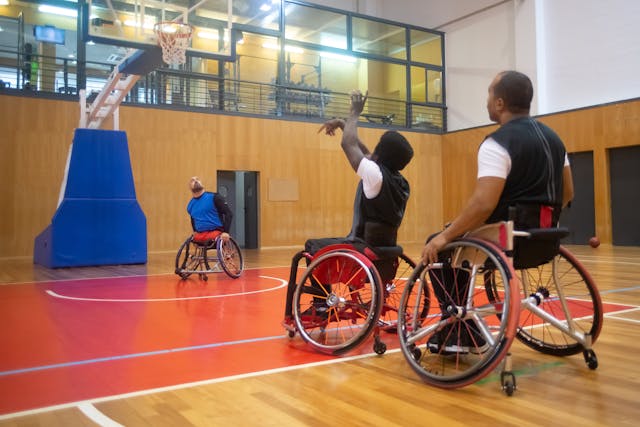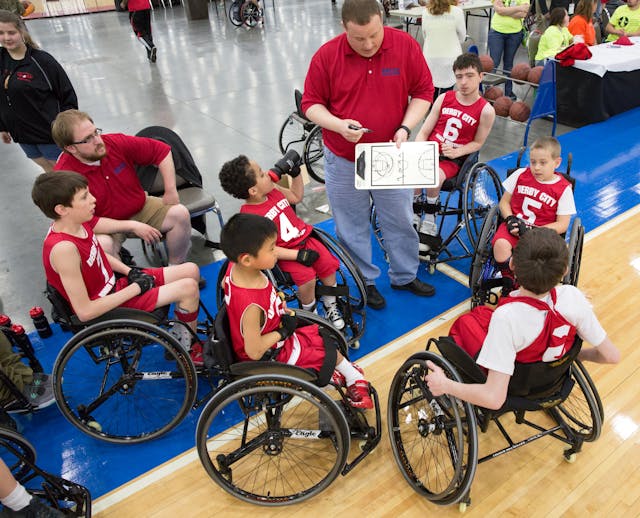A vibrant and competitive sport, wheelchair basketball has captured the attention of spectators worldwide. From a rehabilitation sport for wounded war soldiers to a prominent Paralympic sport, its origins are rooted on tenacity and adaptability. This journey not only demonstrates the sport’s development but also its significant influence on athletes, empowering them and upending social stereotypes about disabilities.
Origins: From Rehabilitation to Recreation
Post-War Rehabilitation
After World War II, thousands of troops returned home with injuries that left them confined to wheelchairs, leading medical specialists to look for ways to improve their physical and mental health. This led to the creation of wheelchair basketball. Basketball became a popular choice as rehabilitation facilities in the US and the UK started including sports into their treatment plans.
The first wheelchair basketball match ever recorded was at the Veterans Administration Hospital in California in 1946. Veterans were able to restore their confidence and mobility via the sport, which gave them a feeling of purpose and community. At first, these were unofficial games that prioritized involvement above rivalry, but they quickly gained popularity.
The Transition to Organized Play
Wheelchair basketball’s growing popularity necessitated the establishment of official regulations and competition. The foundation for standardized play was laid in 1949 when the National Wheelchair Basketball Association (NWBA) was founded in the US. This was a turning point in the sport’s development from a therapeutic endeavor to a structured, competitive sport.

See Also: Adaptive Skiing: 6 Techniques and Must-Have Equipment for Disabled Skiers
The Global Expansion of Wheelchair Basketball
International Recognition
Wheelchair basketball gained popularity abroad in the 1950s and 1960s. Athletes with impairments were given the opportunity to demonstrate their abilities on a worldwide scale with the establishment of events such as the International Stoke Mandeville Games, which later changed its name to the Paralympic Games. Its inclusion in the first Paralympic Games in 1960 solidified the sport’s standing as a respectable and distinguished athletic pursuit.
Wheelchair basketball programs were developed throughout South America, Asia, and Europe, encouraging competitiveness and cross-cultural interaction. The sport was further unified in 1989 with the creation of the International Wheelchair Basketball Federation (IWBF), which standardized regulations and encouraged the sport’s global expansion.
Accessibility and Inclusion
Increased accessibility and improvements in wheelchair technology have also contributed to wheelchair basketball’s global growth. Sports wheelchairs of today are lightweight, strong, and adaptable, allowing athletes to reach their maximum potential. The activity is now more accessible, enabling participation from people of all backgrounds thanks to initiatives to supply reasonably priced gear and instruction.
The Impact of Wheelchair Basketball on Athletes
Physical and Mental Health Benefits
For athletes, wheelchair basketball has many positive effects on their physical and emotional well-being. Strength, endurance, and agility are required for the sport, which promotes general fitness and enhances cardiovascular health. People who regularly participate also improve their coordination, balance, and posture.
Sport helps people with disabilities feel less alone and depressed by giving them a sense of accomplishment and purpose. Wheelchair basketball fosters a supportive environment by encouraging teamwork and togetherness, which increases resilience and self-worth.
Empowerment and Advocacy
Wheelchair basketball serves as a means of empowerment for many athletes, making it more than just a sport. High-level competition dispels social misconceptions about disabilities and highlights the strengths and tenacity of those with physical disabilities. Athletes frequently turn become disability rights activists, utilizing their platforms to advance accessibility and inclusivity.
Many others have been motivated to follow their passions in spite of obstacles by well-known individuals like Patrick Anderson, who is considered to be among the best wheelchair basketball players of all time. These role models show that a handicap is a distinctive feature of identity rather than a constraint.

Wheelchair Basketball in the Paralympic Games
A Prestigious Platform
The Paralympic Games’ introduction of wheelchair basketball has greatly increased its visibility. Due of the extraordinary talent and athleticism of its participants, the sport receives extensive media coverage. Athletes frequently use Paralympic success as a springboard to acquire sponsorships and notoriety, which further breaks down barriers.
Competitive Excellence
Wheelchair basketball has seen a sharp increase in competition over time. Teams spend a lot of money on strategy, analysis, and training, so the Paralympics are a display of top performance. In addition to increasing the sport’s attractiveness, this development has spurred advancements in coaching methods and wheelchair design.
Challenges and Future Prospects
Barriers to Entry
Wheelchair basketball continues to confront obstacles in spite of its expansion. For many prospective athletes, especially in underdeveloped nations, access to specialist equipment and training facilities continues to be a hurdle. In order to guarantee the sport’s continuous growth and inclusivity, efforts must be made to rectify these inequities.
Promoting Gender Equality
Promoting gender equality in sports is another area of emphasis. Even though wheelchair basketball for women has advanced significantly, there are still gaps in opportunity, money, and media attention. Efforts to promote female athletes and raise awareness are crucial to creating a level playing field.
Technological Advancements
It’s likely that technology developments will influence wheelchair basketball in the future. While virtual reality and other digital tools have the potential to transform training methods, wheelchair design and material innovations could improve performance and safety. The sport is expected to reach new heights as a result of these advances.
Conclusion
Wheelchair basketball’s transformation from a therapeutic sport to a competitive Paralympic sport is evidence of the tenacity and inventiveness of people. It has broken down boundaries and changed how people view disabilities by giving countless people a chance to succeed. Future generations of athletes could be greatly inspired and empowered by the sport as it develops further, demonstrating that perseverance and teamwork can get you over any challenge.
Wheelchair basketball is more than just a game because of its lengthy history and significant influence; it’s a celebration of fortitude, camaraderie, and the unwavering spirit of its participants.
Another Must-Read: Discover 10 Adaptive Sports: A Comprehensive Guide for Individuals with Disabilities










